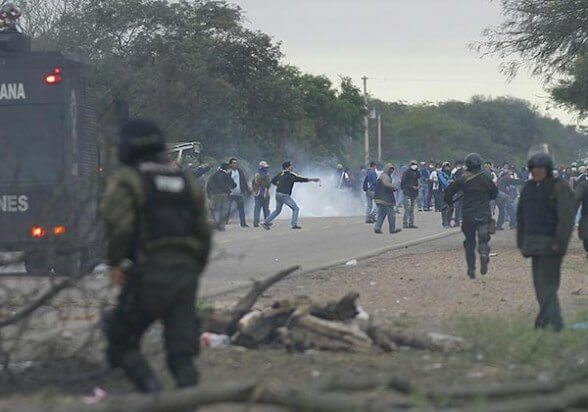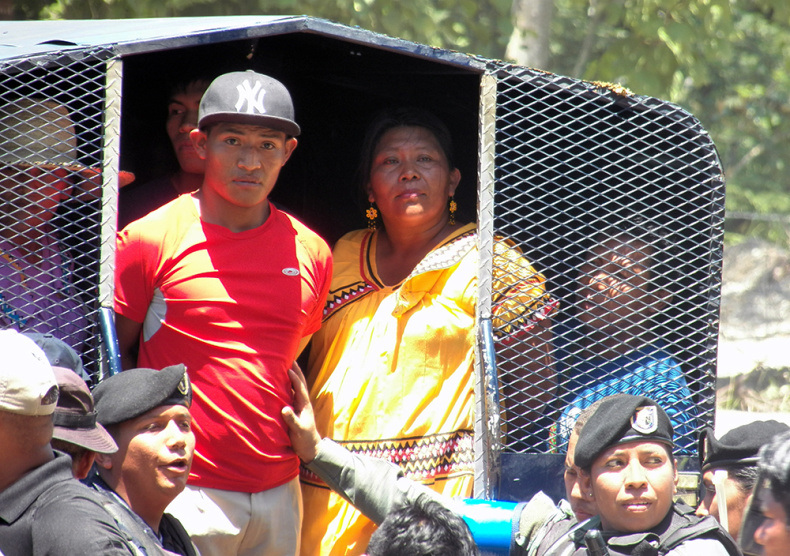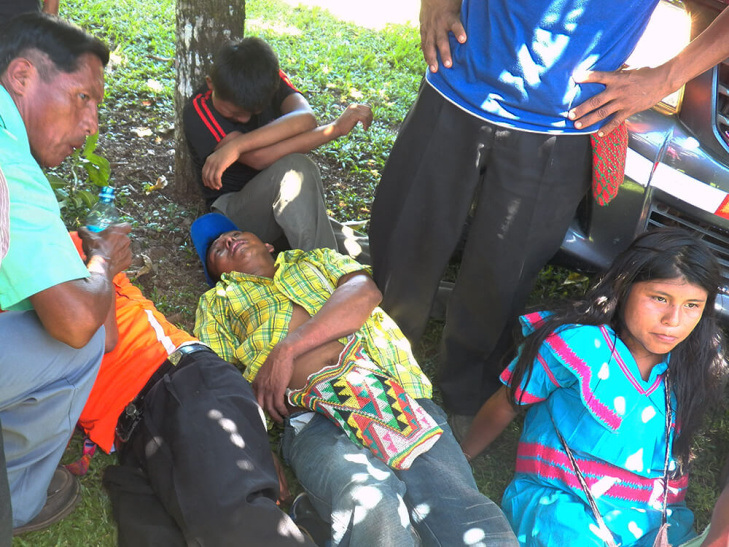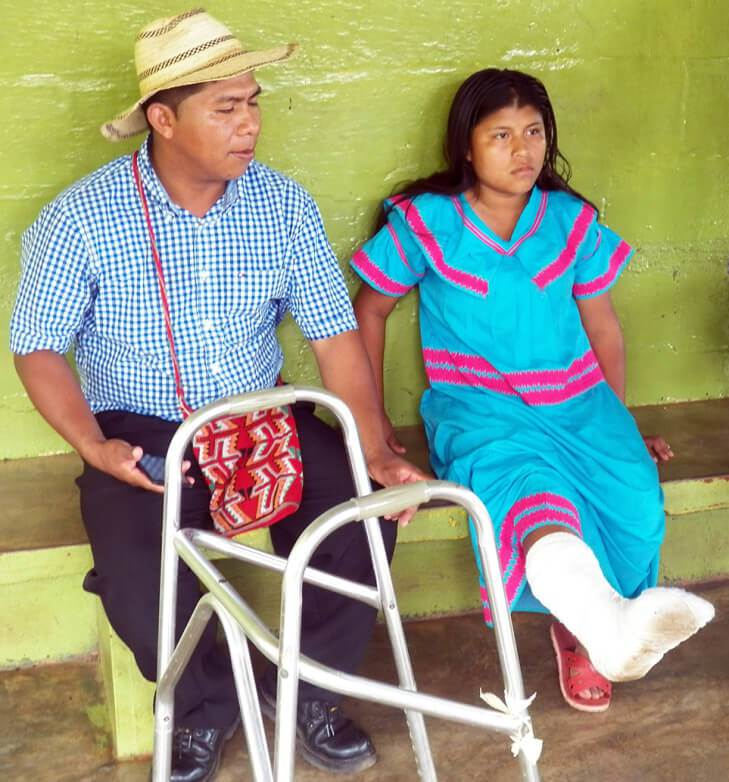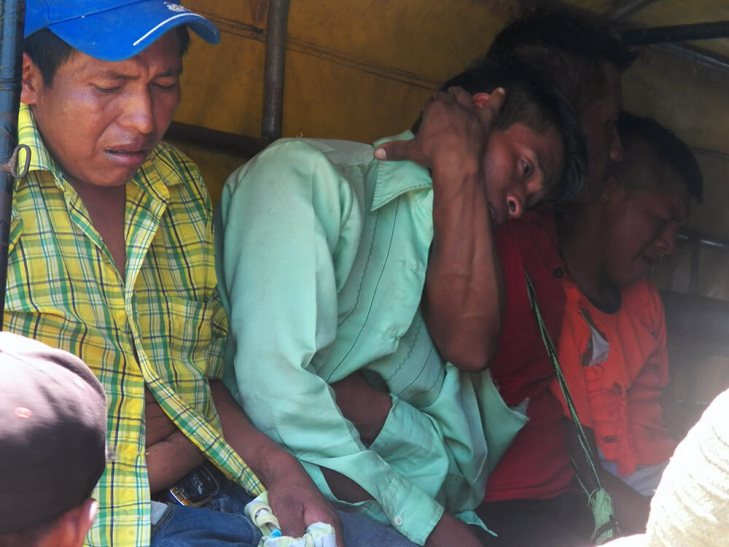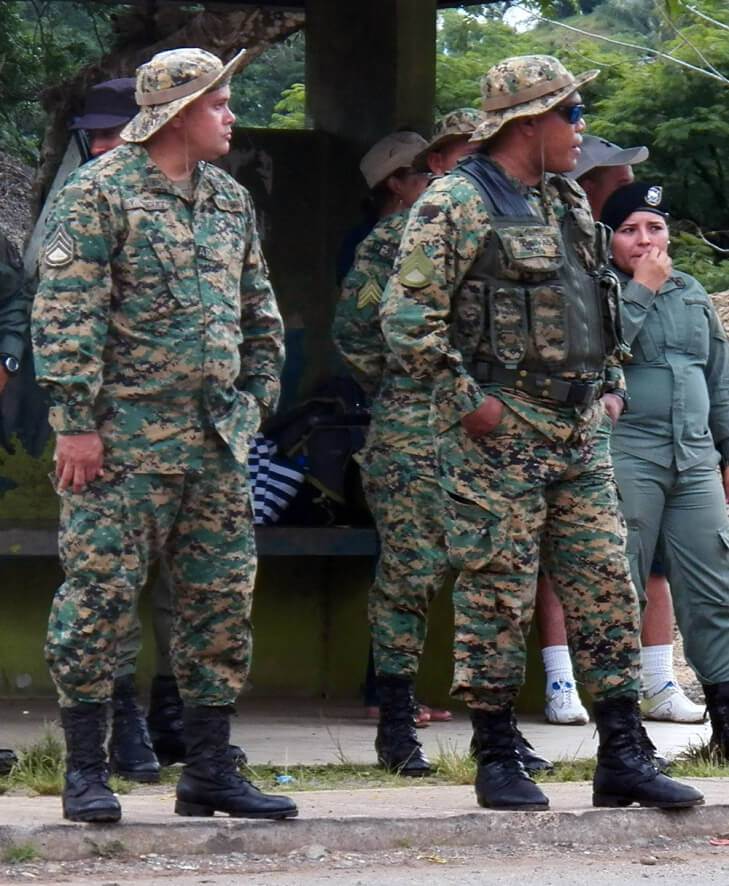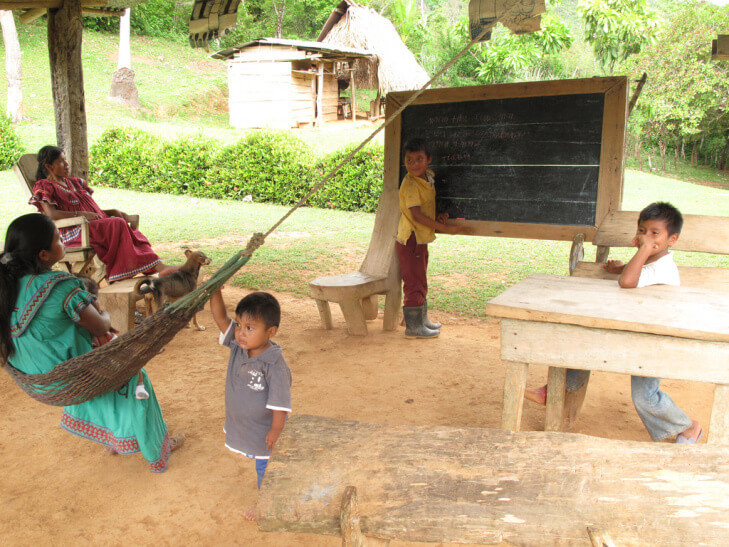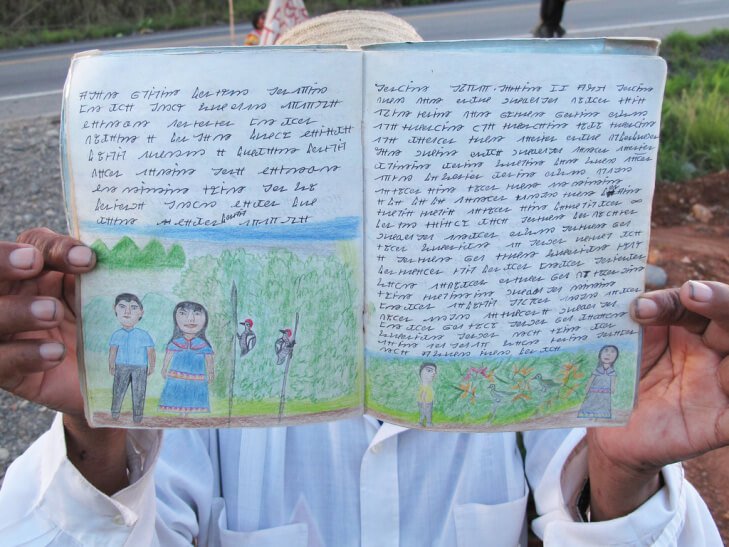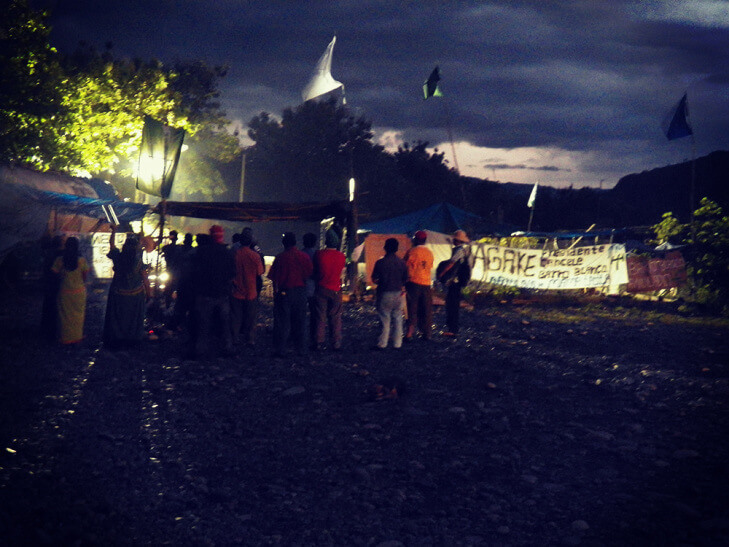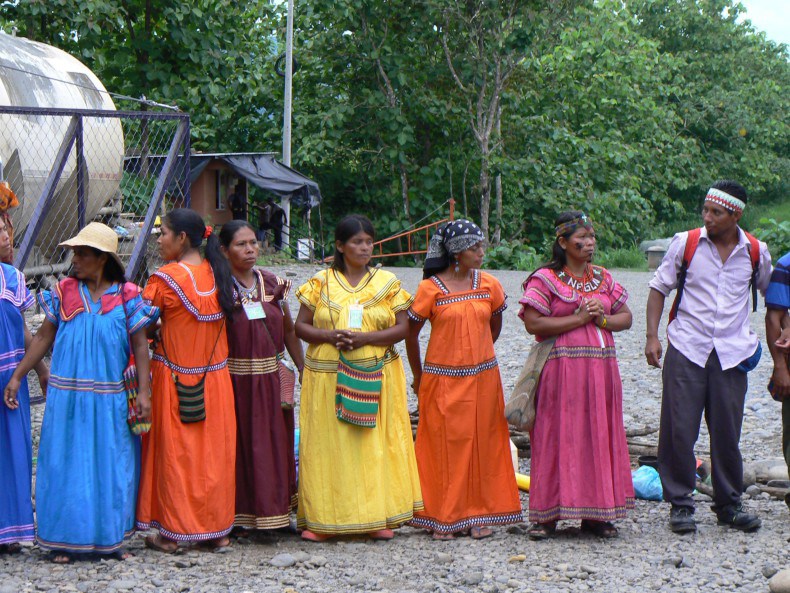
by DGR Colorado Plateau | Aug 5, 2015 | Biodiversity & Habitat Destruction, Colonialism & Conquest, Indigenous Autonomy, Obstruction & Occupation
By Richard Arghiris and Jennifer Kennedy / Intercontinental Cry
June 14, 2015
NGÄBE ISSUE ULTIMATUM TO THE GOVERNMENT OF PANAMA: CANCEL THE PROJECT BY MONDAY
A 30-strong splinter group of Ngäbe from the M10 resistance movement has blocked the entrance to the Barro Blanco hydroelectric dam in western Panama, preventing workers from entering the site. The 15 year struggle of the Tabasará river communities to protect their livelihoods, their culture, and their ancestral heritage now appears to be entering a tense new phase. With negotiations exhausted and the dam 95% complete, M10 has an issued an ultimatum for the government to cancel the project by Monday, June 15, 2015. It is unclear how the government will respond.
“Being Ngäbe-Buglé cultural patrimony,” said Clementina Pérez, part of the group camped at Barro Blanco’s gates. “Our river, our mother earth, our ecology, our existence, we are here to make known to the national and international community that this patrimony belongs to us and to the church of Mama Tata. With the conservation of peace, liberty, justice and unity, liberation and social justice… [we ask] the President of the Republic the cancellation and removal of the dam from our communities, our river and our mother earth, which belong to us as original people of the Americas…”
Funded by European banks – the German Investment Corporation (DEG) and the Dutch Development Bank (FMO) – the dam is set to inundate a string of Ngäbe and campesino communities, all of whom have voiced their objections from the outset. The flood will destroy ancestral petroglyphs, fertile agricultural grounds, and Mama Tata cultural centres, including a unique school where the emerging written script of the Ngäbere language is being developed and disseminated. The dam will significantly impact the river’s marine life, wiping out migratory fish species which many communities – both up and down stream – rely upon for essential protein. None of the Tabasará communities have provided their free, informed and prior consent to the dam, a fact recently confirmed by the FMO’s own independent complaints mechanism (ICM).
“Lenders should have sought greater clarity on whether there was consent to the project from the appropriate indigenous authorities prior to project approval,” said an ICM report, published on May 29, 2015. “[The plan] contains no provision on land acquisition and resettlement and nothing on biodiversity and natural resources management. Neither does it contain any reference to issues related to cultural heritage…”
The report is the latest in a series of professional analyses that pour a thick layer of scorn over the dam project’s owner, Generadora del Istmo (GENISA). Demonstrably unlawful, GENISA has been condemned by numerous independent investigators, the United Nations, several international NGOs, and Panama’s own environmental agency, ANAM, who found a raft of flaws and short-comings in their environmental impact assessment.
But despite failing their own due diligence, the banks appear to have shrugged off the ICM report with an insipid call for “constructive dialogue” and “a solution for a way forward.” In February this year, the FMO chose to threaten the government of Panama after building work was temporarily suspended on the recommendation of ANAM. Writing to the Vice President, the FMO warned that the suspension “May weigh upon future investment decisions, and harm the flow of long-term investments into Panama.”
The government seems to have taken this threat to heart. Panama’s president, Juan Carlos Varela, who was elected to office in 2014, flip-flopped on Barro Blanco before finally falling in line. Last week, while proffering flimsy reassurances about having found a human rights solution, his government left the negotiating table and signaled an end to the suspension of works. M10 claims the work never stopped and has been continuing clandestinely. They are now mobilizing for action.
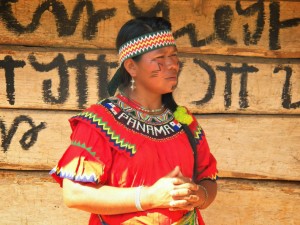
Clementina Perez (Photo: Oscar Sogandares)
“If this situation is not resolved,” said Clementina Pérez, “We will go to the Panamerican highway to ask together, at a national level, the cancellation of Barro Blanco…”
Rising with stark grey walls above the denuded banks of the Tabasará, Barro Blanco has become a symbol of the previous administration, its fundamental violence and contempt for the rule of law. The former President Ricardo Martinelli – now on the run in the United States and facing a corruption probe back home – provoked no less than four major uprisings as he grasped for land and resources in Panama’s indigenous territories. Heavy-handed repression resulted in the deaths of several protesters and bystanders, including an unarmed teenage boy who was shot in the face by police. Barro Blanco is the visible legacy of a proudly thuggish President who serially abused Panama’s Indigenous Peoples and plundered the country at will. Thus far, Varela has been keen to strike a more decent and humane tone. How he now handles the crisis evolving on the banks of the Tabasará River will be a demonstration of his sincerity, or lack of.
From Intercontinental Cry: https://intercontinentalcry.org/ngabe-block-entry-to-barro-blanco-hydro-dam-panama-28186/
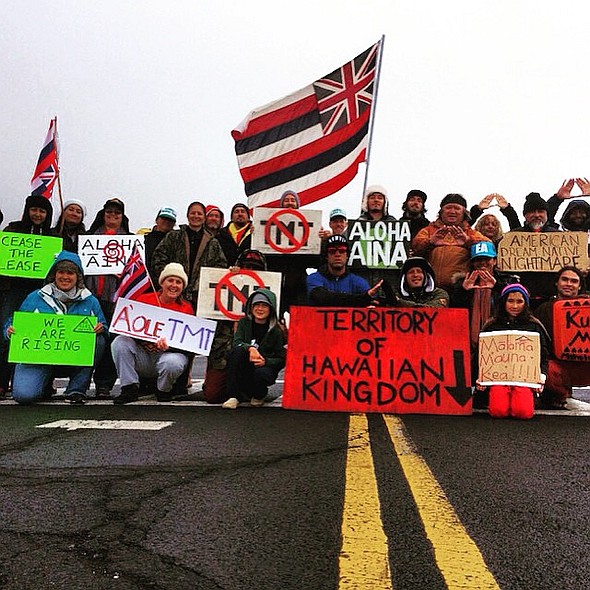
by Deep Green Resistance News Service | Jun 22, 2015 | Direct Action, Strategy & Analysis
By Will Falk / Deep Green Resistance
I went up to Mauna Kea’s summit a few days ago to pule (to pray) with some of the protectors on a ridge inside the Thirty Meter Telescope’s (TMT) proposed construction site. When we reached the site, we were confronted by half a dozen large men in orange vests and hard hats brandishing cameras, audio recorders, and notebooks.
The boss told us we were trespassing on an active construction site and subject to arrest. I looked around and saw nothing but a handful of back-hoes, the open sky at 14,000 feet above sea level, and a sublime, obsidian-colored cinder field stretching to the clouds. Of course, as I’m writing this, construction on Mauna Kea has been suspended for more than two months.
Kaho’okahi Kanuha explained that we were simply here to say some prayers. The boss told us again we were subject to arrest, mumbled into a hand-held radio, signaled to his men, and began recording us with a camera. The six men took up positions surrounding us as we held hands and faced the sky with Kaho’okahi leading some chants. Some of the men folded large arms across their chests glaring at us, others recorded us on camera, and one circled us nervously. I’ve been in a few fist fights in my life – needless, pointless expressions of a toxic masculinity – and I felt like these men were revving themselves up for some sort of scrap.
It was impossible for me to pray like this. Kaho’okahi seemed completely unnerved and when I asked him about it, he said this happens every time he comes to pray. I remember my experiences in Mass when I was younger. I imagine a priest at the altar leading his parish in the prayers that, for Catholics, turn bread and wine into the body and blood of Christ – all while strong men in hard hats patrol the pews and record the liturgy.
This, of course, would never happen. So, I ask: When Kanaka Maoli pray on a mountain exceedingly more beautiful than any basilica or cathedral I’ve ever been in, why are they being harassed like this?
I spent the first six essays in this Protecting Mauna Kea series trying to answer this question. The answers I came up with are validated after spending the last two weeks up here. The TMT project is based on the dominant culture’s sense of entitlement, historical amnesia, and pornification of Hawaiian culture. What could resemble a porn shoot more closely than men with cameras intruding on and recording acts of intimacy?
I think I’ve demonstrated that the TMT project is enabled by a problematic worldview and should not be allowed to proceed. After Governor David Ige’s announcement last week that he would support and enforce the TMT’s construction, the Mauna Kea protectors want the world to know we never expected the State to help us. We must stop the TMT project and we must do it ourselves. The question becomes: “How do we do it?”
The occupation on Mauna Kea is an expression that the protection of Mauna Kea is the people’s responsibility. We cannot trust the government to stop the TMT. We cannot trust the police. We cannot trust the courts. We have to do it ourselves. In other words, nothing has changed since the occupation began over two months ago. In many ways, the occupation on Mauna Kea reflects all of our environmental and social justice movements around the world.
The truth is – on the whole – environmental and social justice movements around the world have been getting their asses kicked. If they weren’t, 200 species a day wouldn’t be going extinct around the world. If they weren’t, we wouldn’t be losing indigenous languages at a rate relatively faster than species. If they weren’t, 95% of North America’s old growth forests wouldn’t have been clear cut. If they weren’t, every mother around the world wouldn’t have dioxin – a known carcinogen – in her breast milk. And, why are they getting our asses kicked? One reason is we’ve trusted those in power to do the right thing for far too long. The good news is – while construction on the Mountain is suspended – we have the opportunity to avoid mistakes other movements have made.
**********************
A couple days ago in a freezing cold, clinging mist, the Mauna Kea protectors called a 5:30 AM meeting in the now-famous crosswalk on the Mauna Kea Access Road to talk strategy in light of Governor Ige’s recent announcement. Some protectors lamented the announcement and were understandably scared about what was coming next. Others maintained that the TMT project was illegal anyway, and the courts would never let it proceed. Still others cited Kingdom of Hawai’i precedents and referred to the recent war crime charges filed with the Canadian government, to assure us the TMT was dead in the water. Finally. the boldest proudly proclaimed – with a hint of the false bravado that often accompanies anxious realizations – construction equipment would have to roll over their dead bodies to get to the construction site.
I stood silently in the circle listening. I am not Hawaiian and have no place arguing with those whose land I presently occupy. My mind was filling with memories of my experiences as a public defender. I recalled the cop in Kenosha, WI where I worked who put a gun to the temple of young Michael Bell’s head and murdered him as his mother and sister watched on for the crime of possibly breaking his bail conditions. I recalled that the cop was promoted and still on the force in Kenosha.
My stomach began churning as I felt that old feeling of helplessness sitting in a wooden chair in a courtroom next to another client being sentenced to prison while there wasn’t a damn thing I could do about it. There was no brilliant legal argument I could make, no impassioned plea the judge would listen to. The judge had power and armed men at his command, and I did not. It was as simple as that.
My heart was tugged back to Turtle Island, the so-called North American continent where the arrival of Europeans has meant the total extermination of dozens of aboriginal peoples. I think of the Taino who were annihilated within a few decades after Columbus’ contact with them. I can almost hear Tecumseh’s voice calling out from now-dead villages in present-day Ohio and Indiana asking what happened to the Pequods, the Narragansetts, and the Pocanokets. These peoples were wiped out by European colonizers while most of Tecumseh’s people, the Shawnee, were removed at gunpoint from their homelands in the Ohio valley hundreds of miles away to Oklahoma.
Some of the protectors here tease me, calling me “America’s ambassador to Hawai’i.” Listening to some of the protectors insist that the courts, the police, and the government would never let the TMT project happen, I wanted to explain that I understand the dominant culture we’re fighting against. I wanted to say I benefit from this culture. I was raised within in. I’ve lived amongst the type of people who run those courts, sit in their government, and become the police. I know what they are capable of and that many of them are sociopaths with no regard for the well-being of those who oppose them.
I didn’t say this, though, because I knew these feelings brought me too close to acting like the White Savior come to save aboriginal peoples from their ignorance. The truth is Kanaka Maoli understand very well – much better than I – the genocidal tendencies of the dominant culture occupying their lands. They do not need my reminder. I write about this now, only to narrate my relief when Kaho’okahi said, “I understand everyone’s concerns, but the way we’re going to win this struggle is pule plus action.”
**********************
Pule plus action. I agree with Kaho’okahi. Protecting Mauna Kea requires a strong spirituality, requires prayers, but it also means real, physical actions in the real, physical world. We need prayers, yes, just like we need those battling the TMT project in the courts, just like we need those signing petitions against the TMT project, just like we need those donating to the Mauna Kea protectors’ bail fund. But, at the end of the day, the surest way to stop the TMT project is to physically, actually stop the TMT project. This is what the encampment on Mauna Kea has always been about. The protectors are determined to place their bodies in between Mauna Kea’s summit and the construction equipment escorted by the police that will soon come to build the telescope.
I hope with all my heart that the courts will make the right decision and prohibit the TMT’s construction. I hope with all my heart that when the police receive their orders to pacify resistance on the Mountain that they will turn in their resignation papers. But, I’m not holding my breath. History has shown over and over again that the courts and the police will not help us.
Hope is not going to keep the destruction off Mauna Kea. It is much more likely that hope will bind us to ineffective strategies like trusting the government and hugging the police when they come to arrest us.
The Mauna Kea protectors insist on observing kapu aloha – a practice of love and respect – on the Mountain. I will not question this practice, but I will point out that our opponents do not observe kapu aloha. I fear that the more effective we become at stopping their project, the more violently they will respond.
I do not write this from a place of despair. I write this to give a clear-eyed vision of the effort it’s going to take. If we’re going to keep the TMT project from completion, we are going to have to do it ourselves. We’re going to have to show up in numbers large enough to overwhelm the police. We’re going to have to produce a mass of humanity thick enough to clog the Mauna Kea Access Road – and we may have to do it day in and day out for weeks. It will take a tremendous amount of bravery, shrewd strategic thinking, and a deep commitment from all of us. Or, in Kaho’okahi’s words, it’s going to take pule plus action. This is nothing new, though, and I believe we will win.
by DGR Colorado Plateau | Mar 8, 2015 | Property & Material Destruction, Repression at Home, Strategy & Analysis
In 1993 Michael Carter was arrested and indicted for underground environmental activism. Since then he’s worked aboveground, fighting timber sales and oil and gas leasing, protecting endangered species, and more. Today, he’s a member of Deep Green Resistance Colorado Plateau, and author of the memoir Kingfishers’ Song: Memories Against Civilization.
Time is Short spoke with him about his actions, underground resistance, and the prospects and problems facing the environmental movement. Due to the length of the interview, we’ve presented it in three installments; go to Part II here, and Part III here.
Time is Short: Can you give a brief description of what it was you did?
Michael Carter: The significant actions were tree spiking—where nails are driven into trees and the timber company warned against cutting them—and sabotaging of road building machinery. We cut down plenty of billboards too, and this got most of the media attention. We did this for about two years in the late ‘80s and early ‘90s, about twenty actions. My brother Sean was also indicted. The FBI tried to round up a larger conspiracy, but that didn’t stick.
TS: How did you approach those actions? What was the context?
MC: We didn’t know a lot about environmental issues or political resistance, so we didn’t have much understanding of context. We had an instinctive dislike of clear cuts, and we had the book The Monkey Wrench Gang. Other people were monkeywrenching, that is, sabotaging industry to protect wilderness, so we had some vague ideas about tactics but no manual, no concrete theory. We knew what Earth First! was, although we weren’t members. It was a conspiracy only in the remotest sense. We had little strategy and the actions were impetuous. If we’d been robbing banks instead, we’d have been shot in the act.
Nor did we really understand how bad the problem was. We thought that deforestation was damaging to the land, but we didn’t get the depth of its implications and we didn’t link it to other atrocities. We just thought that we were on the extreme edge of the marginal issue of forestry. This was before many were talking about global warming or ocean acidification or mass extinction. It all seemed much less severe than now, and of course it was. The losses since then, of species and habitat and pollution, are terrible. No monkeywrenching I know of did anything significant to stop that. It was scattered, aimed at minor targets, and had no aboveground political movement behind it.
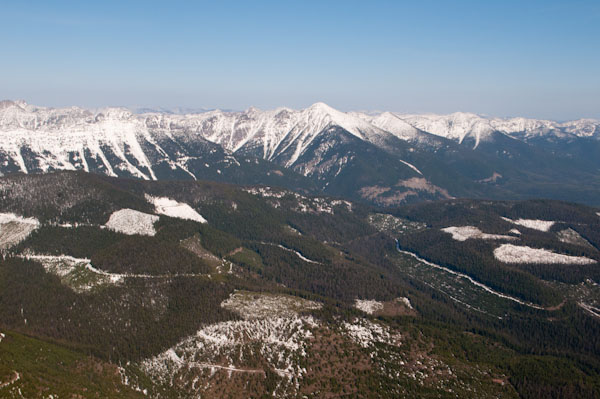
Clearcuts in the Swan Valley, MT near Loon Lake on the slope of Mission Mountains. Photo by George Wuerthner.
TS: What was the public response to your actions?
MC: They saw them as vandalism, mindlessly criminal, even if they were politically motivated. This was before 9/11, before the Oklahoma City bombing; the idea of terrorism wasn’t so powerful, so our actions weren’t taken nearly as seriously as they would be now.
We were charged by the state of Montana with criminal mischief and criminal endangerment. The state’s evidence was solid enough we thought we couldn’t win a trial, so we pled guilty on the chance the judge wouldn’t send us to prison. Our defense was to say, “We’re sorry we did it, it was motivated by sincerity but it was dumb.” And that was true. We were able to get our charges reduced from criminal endangerment to criminal mischief. I got a 19 year suspended prison sentence, Sean got 9 years suspended. We both had to pay a lot of money, some $40,000, but I only spent three months in county jail and Sean got out of a jail sentence altogether. We were lucky.
TS: As you said, this was before the obsessive fear of terrorism. How do you think that played into your trial and indictment, and how do you think it would be different today?
MC: Had it happened after any big terrorism event, they would have sent us to prison, there’s no doubt about that. States have to maintain a level of constant fear and prove themselves able to protect citizens.
The irony was, I’m not sure I wanted to be serious—there seemed to be something protective in not being all that effective, in being intentionally quixotic, in being a little cute about it. There was a particularly comical aspect to cutting down billboards, and that was helpful only when I was arrested. It made it look less like terrorism and more like reckless things I did when I was drunk, and a lot of people approved of it because they thought billboards were tacky. I want to emphasize that cutting down billboards is nothing I’d advise anyone to consider, only that a little bit of public approval made a surprising difference to my morale, and may have positively influenced sentencing. But the point, of course, is to be effective and not get caught in the first place. These days, if someone gets caught in underground actions, they will be in a lot more trouble than ever before.
TS: How did you get caught?
We left fingerprints and tire tracks, we rented equipment under our own names—like an acetylene torch used to cut down steel billboard posts—and we told people who didn’t need to know about it. We assumed we were safe if they didn’t catch us in the act and because our fingerprints weren’t on file, and we couldn’t have been more wrong. The cops can subpoena anyone’s fingerprints, and use that evidence for something in the past. The importance of security can’t be overstated—and we didn’t have any. Even with a couple rudimentary precautions, we might have saved ourselves the whole ordeal of getting caught. If we’d read the security chapter of Dave Foreman’s book Ecodefense, I don’t think we would have even come under suspicion. Anyone taking any action, above- or underground, needs to take the time to learn security well.
It’s not just saving yourself the anguish of arrest and prison time. If you’re rigorous about security, you might be able to have a real chance at changing how the future of the planet plays out. You can have no impact at all in a jail cell. In our case, we definitely could have stopped timber sales with tree spiking even though that tactic was extremely unpopular politically. It was seen as an act of violence against innocent lumber mill workers instead of a preventative measure to protect forests. The dilemma never got past that stage, though. We had little chance of having any reasoned tactical considerations—let alone making reasoned decisions—because we were always a little too afraid of being caught. With good reason, it turns out.
TS: What have you learned from your experience? Looking back on what you did all those years ago, what’s your perspective on your actions now? Is there anything you would have done differently?
MC: Well I definitely would have taken steps to not get caught. I would have picked my targets more carefully, and I would have entered into an understanding with myself that while my enemy is composed of people, it’s only a system, inhuman and relentless. It can’t be reasoned with; it has no sanity, no sense of morality, no love of anything. Its job is to consume. I would have tried to focus on that guiding fact, and not on the people running it or who were dependent on it. I would have tried to find the weaknesses in the system, and then attacked those.
I’d have tried not to allow my emotions to dictate my strategy or actions. Emotions might get me there in the first place—I don’t think you could get to such a desperate point without a strong emotional response—but once I arrived at the decision to act, I would have done everything I could to think like a soldier, find a competent group to join with, and pick expensive and hard-to-replace targets.
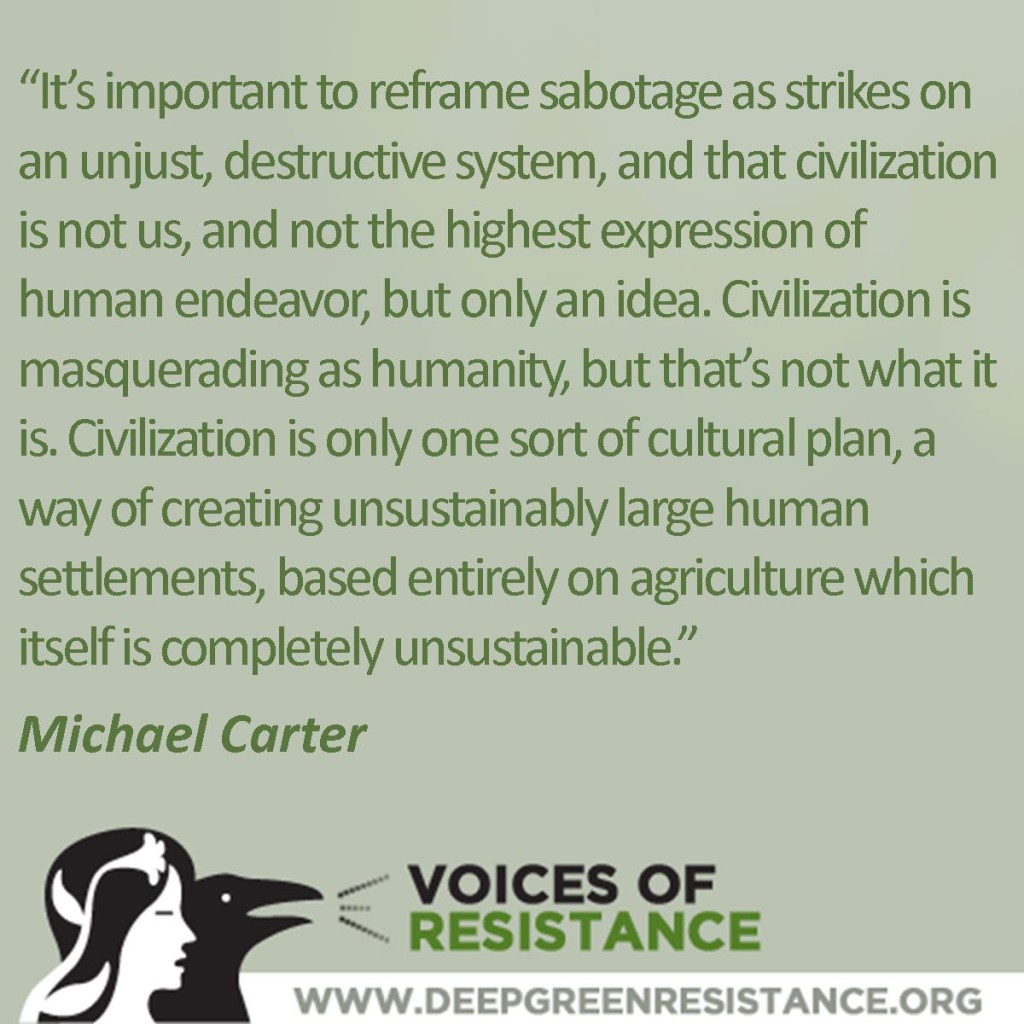
TS: I assume you didn’t just wake up one day and decide to attack bulldozers and billboards. What was your path from being apolitical to having the determination and the passion to do what you did?
MC: When I was struggling with high school, my brother loaned me a stack of Edward Abbey books, which presented the idea that wilderness is the real world, precious above all else. The other part was living in northwest Montana, where you see deforestation anywhere you look. You can’t not notice it, and there’s something about those scalped hills and skid trails and roads that triggers a visceral, angry response. It’s less abstract than atmospheric carbon or drift-net fishing. You don’t see those things the way you see denuded mountainsides. My family heated the house with wood, and we would sometimes get it out of slash piles in the middle of clearcuts. I had lots of firsthand exposure to deforested land. I wondered why the Sierra Club didn’t do something about it, how it could be allowed. We would occasionally go to Canada, and it was even worse up there. No one can feel despair like a teenager, and I had it in spades. If Greenpeace won’t stop this, I reasoned, well then I will.
I started building an identity around this, though, and that’s disastrous for a person choosing underground resistance. You naturally want others to know and appreciate your feelings and accomplishments, especially when you’re young, but the dilemma underground fighters face is that they must present another, blander identity to the world. That’s hard to do.
TS: You were fairly isolated in your actions, and you’ve emphasized the importance of a larger context. Do you see those two ideas connecting? Do you think saboteurs should be acting in a larger movement?
MC: I think saving the planet relies completely on the coordinated actions of underground cells coupled with an aboveground political movement that isn’t directly involved in underground actions. When I was underground, I had no hope of building a network, mostly because of a lack of emotional and political maturity. I also didn’t have the technological or strategic savvy, or a means of communicating with others. The actions themselves were mostly symbolic, and symbolic actions are a huge waste of risk. They’re a waste of political capital too. Most everyone is going to disagree with underground activism and it’s not going to change anyone’s mind about the policy issue—hardly anything will—so it has to count in the material realm. If people are ready and willing to risk their lives and their freedom then they should fight to win, not just to make some sort of abstract point.
TS: After you were arrested, what support—if any—did you receive from folks on the outside, and what support would you have wanted to receive?
MC: The most important support was financial, but there wasn’t a lot of it. Our plea bargain didn’t guarantee we wouldn’t go to prison. We were also worried that the feds would indict us for racketeering, an anti-Mafia charge with serious minimum sentencing. If we’d had more legal defense financing we’d of course have felt a lot more secure, but twenty years of reflection tells me we didn’t really deserve it considering how poorly we executed the actions, what little effect they caused.
That sounds like I’m being awfully hard on myself, and hindsight is always 20/20, but the point is that a legal crisis is exhausting and expensive. Your community will question whether your actions are worthy of the price they’ll have to pay if you’re caught. My actions were not.
Even so, I appreciated any sort of support. Hearing from the outside in jail is better than you’d believe. A lot of Earth First! Journal readers sent me anonymous letters. I wrote back and forth with one of the women who was jailed for noncooperation with a federal grand jury investigating the Animal Liberation Front in Washington. Seeing approving letters to the editor in the papers was also great. Just knowing that the whole world isn’t your enemy, that someone is thinking about you and appreciates what you did, is priceless.
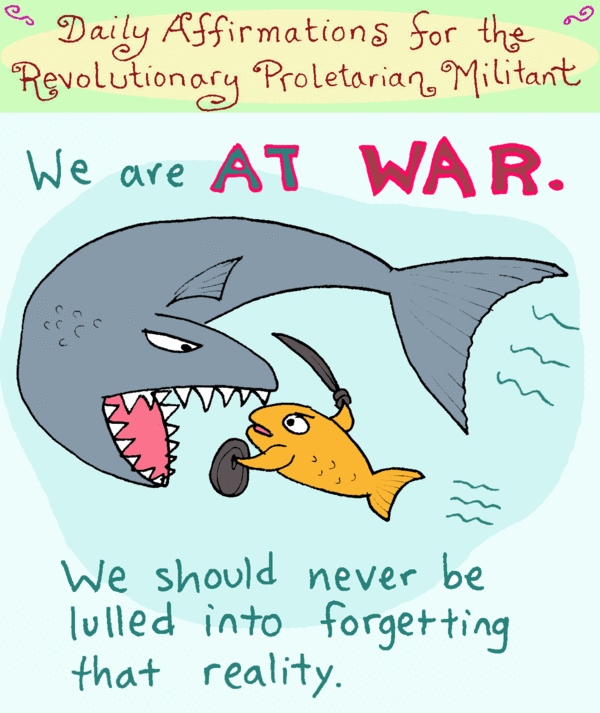
Artwork by Stephanie McMillan
TS: Do you still think militant and illegal forms of direct action and sabotage are justified? Why?
MC: I do, yes. In an ideal world I don’t think violence is the best way to accomplish anything, but obviously this isn’t an ideal world. Our circumstances are getting worse and worse—overpopulation, pollution, oceanic dead zones, you name it—and any options for a decent and dignified future for humanity are dwindling day by day, so what choice does that leave us? Individual attempts at sustainable living won’t work so long as the industrial system is running. The dismantling of infrastructure is the most important missing piece right now. It’s where the system is most vulnerable, so it should be employed right away. It can be effective, but it has to be responsible, careful, and extraordinarily smart.
One of the reasons underground political actions are so unpopular is that they’re always presented as attacks on individuals, rather than on a system. I think it’s important to reframe sabotage as strikes on an unjust, destructive system, and that civilization is not us, and not the highest expression of human endeavor, but only an idea. Civilization is masquerading as humanity, but that’s not what it is. Civilization is only one sort of cultural plan, a way of creating unsustainably large human settlements, based entirely on agriculture which itself is completely unsustainable.
The argument that militant actions are counterproductive has a little bit of merit because the scale they’ve happened on hasn’t been large enough to have any impact. For example, the Earth Liberation Front burning SUV’s. You’re left with the political fallout, the mainstream activists distancing themselves and all the other bad stuff that comes with it, but you don’t have any measurable gain, in reducing carbon emissions, say. Sabotage needs to happen on a larger scale, against more expensive targets, to be impactful. Fighters need to think big. That’s how militaries accomplish their goals—by acting against systems. They blow up bridges, they take out buildings, they disable the enemy arsenal, they kill the enemy—that’s how they function. I agree activists don’t want to identify with militarism, but it’s foolhardy to not consider what’s actually going to get the job done, and militaries know how to do that. No moral code will matter if the biosphere collapses. Doctrinal non-violence isn’t going to have any relevance in a world that’s 20 degrees hotter than it is now.
I wish an effective movement could be nonviolent, but we just don’t have enough social cohesion to orchestrate that kind of thing. There’s so few of us who give a shit, and we’re scattered, isolated, and disenfranchised. We don’t have adequate numbers, influence, or power, and I don’t see that changing. Everywhere we look we’re losing, because we don’t have a movement that can say, “No. You’re not going to do that. We will stop this, whatever it takes,” and back that up. Aboveground activists need to advocate a lesser evil, to continually pose the question of what is worse: that some property was destroyed, or that sea shells are dissolving in acid oceans? Underground activists need to act that out. It’s not a rhetorical question.
We need to remember, too, that small numbers of people can engineer profound changes when their actions are wisely leveraged. Very few took part in the resistance movements of World War II, but they made all the difference to ultimately defeating the Axis.
Interview continues here.
Time is Short: Reports, Reflections & Analysis on Underground Resistance is a bulletin dedicated to promoting and normalizing underground resistance, as well as dissecting and studying its forms and implementation, including essays and articles about underground resistance, surveys of current and historical resistance movements, militant theory and praxis, strategic analysis, and more. We welcome you to contact us with comments, questions, or other ideas at undergroundpromotion@deepgreenresistance.org
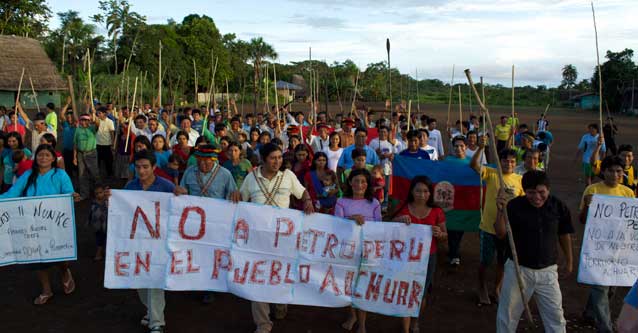
by Deep Green Resistance News Service | Jan 28, 2015 | Indigenous Autonomy, Obstruction & Occupation
By teleSUR
Indigenous communities in Peru occupied 14 oil wells, paralyzing South American energy firm Pluspetrol’s production, in a protest to demand better compensation for the use of their land.
Some 380 members of the Achuar community took control of the facilities in Peru’s northern Amazon region of Loreto Monday, halting the production of some 3,100 barrels of crude oil. Pluspetrol said in a statement that the protesters also seized eight boats on the Tigre River, including two that provided supplies for the company.
Pluspetrol has been operating in Loreto in block 1-AB since 2001 and has been the target of many indigenous protests in the last few years, demanding both compensation for land exploitation and the cleanup of contamination from spilled crude oil.
Carlos Sandi, president of local indigenous and environmentalist group Feconaco, said the community was demanding better compensation for the exploitation of their land, including the installation of an industrial sawmill and the development of a community-run enterprise to help create jobs for the locals in the area.
“They have taken their measures of protest and are waiting for dialogue to resolve this as soon as possible,” Sandi told Reuters.
However, there seems little chance of a dialogue since, according to Pluspetrol, the community should not receive compensation because it is not within the area of direct influence of oil operations.
Its contract on the lot expires in August, while the government has not announced a new bid date for the rights to continue developing on the block.
From teleSUR: http://www.telesurtv.net/english/contenidos/2015/01/28/noticia_0024.html
